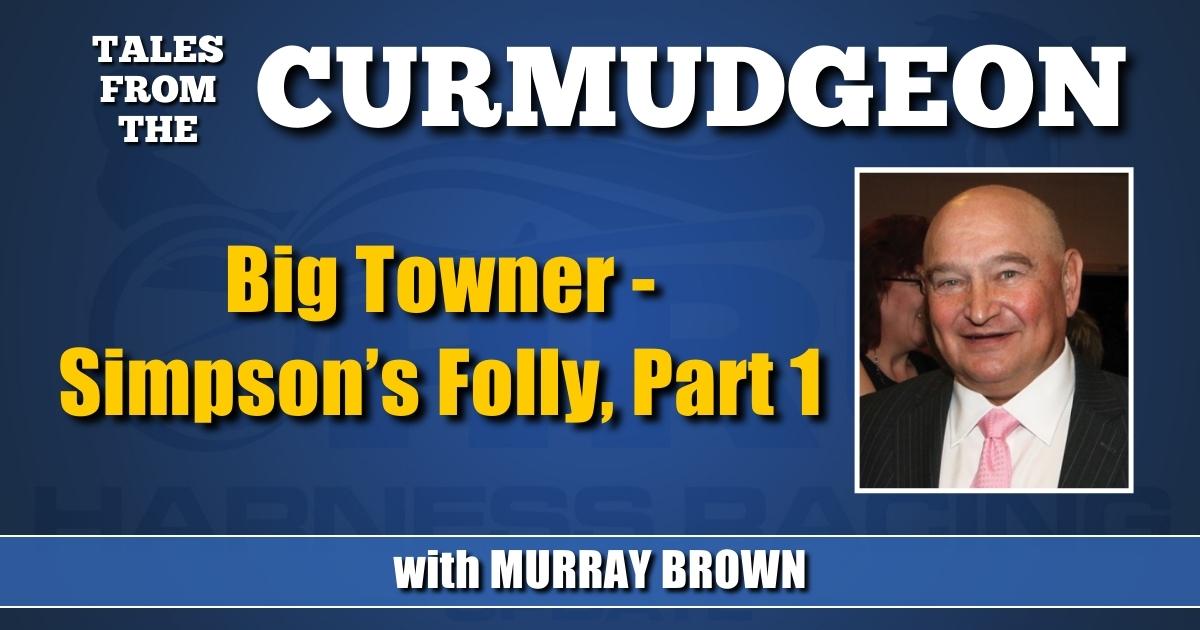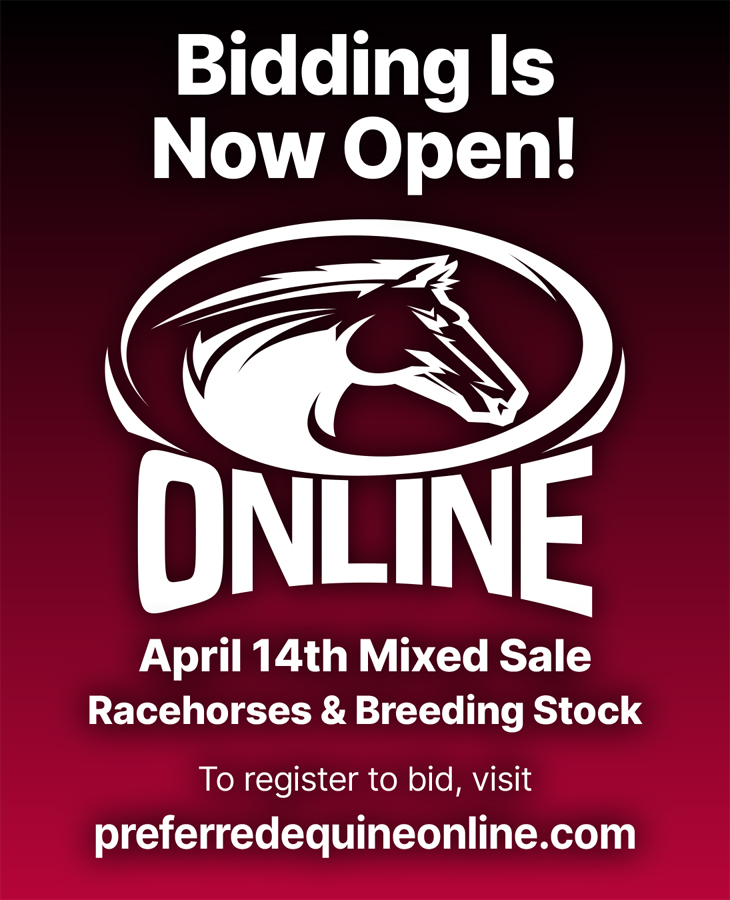Big Towner — Simpson’s Folly, Part 1
by Murray Brown
Simpson’s Folly was the name assigned to Big Towner by Tony Pedone a major — maybe the major — horse owner during the glory years of the 1980s.
Pedone questioned, “How could a son of Gene Abbe, out of a rather nondescript Shadow Wave mare, who sold for $5,700 as a yearling, be worthy of stud duty at harness racing’s greatest nursery?
“Standing horses like Big Towner will end up destroying Hanover. John Simpson doing it will be known as Simpson’s Folly.”
Big Towner was bred by Ohio natives Florence Startsman and Paul Gardner. He was purchased as a yearling from the Blooded Horse Sale in 1975 by the trio of Maryland owners Pat Kelly, Jerry Post and Richard Bissette. He was lightly raced at 2, winning five of six starts and took an unimpressive record of 2.05.4h while earning $3,972.
At 3, on the advice of Mort Finder, the owner of one of New York’s premier breeding farms Pine Hollow Stud and a friend of Kelly’s, Big Towner was sent to New York trainer Lee Broglio where he won 12 of 22 starts and earned $295,012 on his way to capturing the Monticello OTB Classic (video here) and dominating the New York Sires Stakes.
He came back at 4, once again sweeping the NYSS, earning $248,142 and becoming a dominating New York free-for-aller. It was during his 4-year-old season that Hanover Shoe Farms came into the picture.
Simpson Jr. was stabled at Vernon Downs. Each Saturday evening following the Vernon races, Simpson Jr. and his wife Lois would watch the Stan Bergstein and Spencer Ross hosted racing show from Roosevelt Raceway.
It seemed as though every week, a horse named Big Towner would win: dominating the free-for-all events.
Simpson Jr. would speak with his dad each Sunday morning, recounting what was happening with his stable. Invariably, the conversation would steer to the horse whose exploits he would be praising.
“Dad, this is a truly great horse,” Simpson Jr. said. “Hanover needs to get him to stand at the Farms. Not only is he a great horse, but he also represents a great outcross. You could probably breed him to just about every pacing mare on the farm.”
Usually, his father’s response would be something to the effect of “Why would Hanover be interested in standing a son of Gene Abbe who had no great 2-year-old ability and virtually no Grand Circuit wins?” Simpson Jr. would invariably repeat: “This is a truly great horse, dad. The only reason he doesn’t have Grand Circuit wins is because he wasn’t eligible to many. Hanover needs to buy him and stand him. You will never regret doing it.”
Finally, likely more to rid himself of his son’s weekly sermons, Simpson Sr. agreed to investigate the horse’s availability. He asked this scribe if he knew the principals involved in the horse’s ownership.
“I don’t,” was my response. “But I’m pretty sure that Mort Finder is friendly with Pat Kelly, one of the horse’s owners. I can get in touch with Bob Boni (who at the time was Finder’s right-hand man) and see how the land lays.”
Boni and this scribe were to meet in Columbia, MD, to go over Pine Hollow Farms yearling pedigrees for the upcoming Harrisburg sale. There was no such thing as the Internet back then. Rather than go back and forth over the phone, we thought it would be a good idea to meet at a mid-point. I thought that might also be the ideal time to get our oar in the water regarding Big Towner.
The exact details of the deal are somewhat foggy. Boni said that he believed the principals had set a price of $750,000 for Big Towner and he said he would speak to Finder and determine whether the owners were interested in selling him to Hanover for that price.
I went back to Simpson Sr. recounting the conversation with Boni.
Boni spoke to Finder who contacted Kelly.
Simpson Sr. was okay with the price and so were Big Towner’s owners. An agreement to purchase the horse for $750,000 was entered with Kelly retaining part of his ownership position and Max Hempt buying a portion. Hanover would own the rest.
Looking back, I believe that if Hanover had come up with a reasonable counteroffer, they likely would have agreed to it. I sure wasn’t aware of any other prominent breeder looking to stand the horse. But that wasn’t Simpson Sr.’s way. He was either all in or not in at all.
Big Towner was to stand at Hanover. His first crop arrived in 1980. They were generally speaking a good-looking group of foals.
That first group numbered 68. Simpson Jr. wasn’t fooling when he said that Big Towner would make a great outcross.
Of the 68 foals, they were out of mares sired by 34 different stallions. There were only two stallions who had sired the dams of more than two of the yearlings. They were Tar Heel with a whopping 20, almost a third of the entire crop and Bye Bye Byrd with three. There were several fairly innocuous names among pacers such as Adios Don, Afton Judge, Caleb, Cash Wil, Hoot Mon, Kat Byrd, Majestic Hanover, Miracle Knight, Tarport Count, Tarport Neil and Winter Time, who were represented as the sires of the dams of members of that first crop.
There were no stars from that first crop, but they were a solid group. Twelve of its members earned over $100,000 and they gave an inkling of what kind of broodmare sire he might become. Among the stars from that first crop of broodmares were the dams of Tyler Town ($783,093) and Cavalier Semalu ($626,051).
Crop number two numbered 65 and they included 17 winners of over $100,000. They ended up earning almost twice as much as the first crop, $6,342,545 compared to $3,497,781. Whereas crop number one was not recognized as having stars in its midst, crop two overshadowed its predecessor with three significant ones: the 2-Year-Old Pacing Colt of 1983, Walton Hanover ($802,741), the world champion Lustras Big Guy ($977,914) and Apache Circle ($660,248).
Crop No. 3 hit the third-year stallion jinx. It numbered only 49. But in that number were nine $100,000 winners including his first million-dollar winner Broadway Express ($1,141,726), the sensational filly Brees Brief ($535,027) and another sensational filly in Rodine Hanover ($231,630), who was to have as great an effect on the breed as any filly of the modern era. She is the dam of Real Artist ($424,951) and Michelles Revenge ($427,157), grandam of the world champion Worldly Beauty ($1,900,255) and Art Major ($2,727,224) and the third dam of world champion Captaintreacherous ($3,148,657), Rock N Roll World ($712,737), Wake Up Peter ($907,535), Peaky Sneaky ($772,518) and the progenitor of the best branch of the greatest speed family in harness racing.
Big Towner went on to sire a total of five millionaires and 62 winners of over $500,000. The total earnings by his sons and daughters are $118,217,494. He was the leading money winning sire of the breed in 1989 and finished second in 1988.
One might think by the total number of Tar Heel mares bred to Big Towner that it would be the best nick for him. That was not the case. Albatross mares when bred to Big Towner produced more than double the number of $500,000 winners as the next leading sire with eight. Next in line with three each are: Meadow Skipper and Most Happy Fella. If one were a believer in nicks, the obvious ones would be Meadow Skipper and his sons.
The fact that Most Happy Fella mares are second puts to rest the vicious rumor that Big Towner was not sired by Gene Abbe: that his real sire was Most Happy Fella who stood alongside him at Blue Chip Farms. To that, I say nonsense. It is amazing to me that some people are always looking to make negatives out of positives.
It is even more amazing that this vicious rumor was promulgated by several people who certainly should have known better.
Next week, Big Towner — both a great filly sire and an even greater sire of broodmares.

















